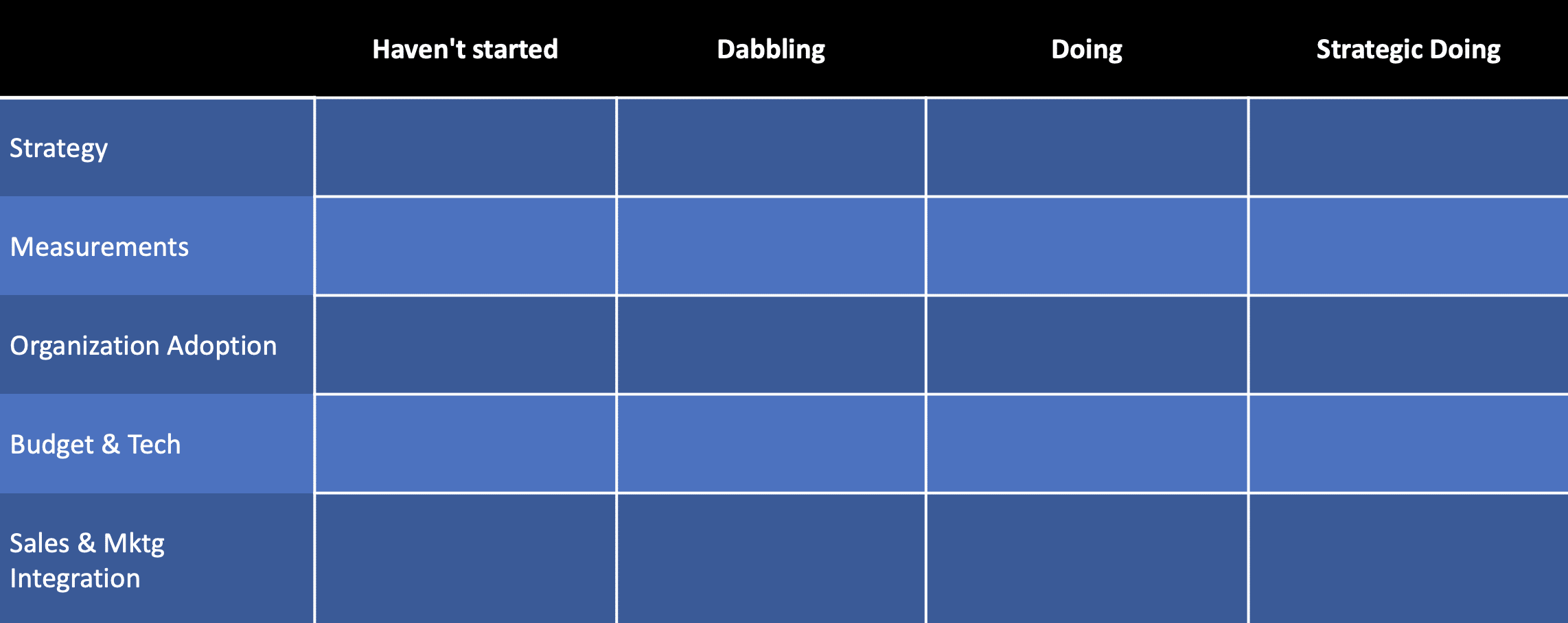Introduction
Organizations come to their Pardot demand generation strategy from many different places and stages. It would be unfair to say this organization is doing great and this one is doing poorly by benchmarking against one set of numbers or outcomes. My belief as a Pardot consultant, is effectiveness is measured by getting to that next step. Growth. Otherwise, everything you do will be mired in a feeling of ineffectiveness and being behind the curve.
The key to leveraging Pardot for demand generation is understanding where you are today and where you need to get to. This involves an honest and transparent audit of the current situation.
We’ve created a matrix and ebook to give you a framework for having those discussions. Download it now to follow along.
Who Should Be Involved?
Everyone! Ok, well a lot of people. As a marketer, I have learned one thing about data analysis. The more data points you receive the lower the possibility for error and bias from one person. If you involve 3 people vs 30 people the chances you are surfacing biases more than truths are greater. Bring various departments into the process and ask individuals in those departments to be involved not just because of their status in the department but also based on their potential to be invested in giving you valuable feedback.
Not everyone in your organization knows all of the things the marketing department is doing. Use this opportunity to not just elicit feedback but to also educate other departments on current initiatives.
What is the Process?
Define the Ask

The end goal is to get meaningful information on this matrix. The matrix is designed to measure your demand generation journey in five key areas; Strategy, Measurements, Organization Adoption, Budget & Tech, Sales & Marketing Integration.
I purposely do not use a rating system with numbers or grades. This isn’t about good or bad it is about where are we at and where are we going next.
Instruct your team to identify where they believe your organization is at in each of the five areas based on the four-part continuum. Feel free to change up the headers to something you believe will resonate with your group.
Tip:

Provide some “guiding” text to help your participants understand what it means to be at each stage. Use wording that is specific to your organization and current Pardot demand generation initiatives.
Be prepared to answer questions
Instruct the team to ask any and all questions of you. Keep in mind this is a two-way educational process. This is a chance for them to educate you on where others see the marketing department’s effectiveness. It is also an opportunity for you to share what the department does and how it affects the overall organization. Keep in mind; give factual answers and not ones that will sway their input one way or the other.
What do you do with the Results?
Of course, all of this is for naught if you don’t do anything with the feedback. Keep in mind this is the very beginning of the demand generation strategy process. You are only looking at where you are and how effectively you are leveraging Pardot. This won’t tell you what programs to put in place. It won’t tell you how to redesign Pardot. It is truly your starting place, which is why there are no wrong answers.
Step 1 – Identify what it takes to get to the next level.
This is VERY important. Do not identify what it takes to go from “Haven’t Started to Strategic Doing.” I guarantee that is the fastest way to ineffectiveness. Only identify the next step.
As the philosopher, Princess Anna of Arendelle says, “Do the next right thing.”
You may currently be sending out newsletters via Pardot and measuring KPI’s such as open rates and unique clicks. The next step wouldn’t be a full-blown multi-channel demand generation program that measures full-funnel effectiveness.
Step 2 – Choose a champion for each of the five core areas.
Let’s face it, in a small organization all five may be one person but in a larger organization, it may be five different people. In an enterprise organization, it may be five teams. Even if it is a group of teams still identify that one person that is the champion responsible for the next level.
Step 3 – Either as a team or as the champion of the five core areas identify specific and measurable results that will constitute you have reached that next level. It isn’t just about the numbers and knowing you’ve reached a goal. The numbers should represent what you are trying to achieve as an organization. A higher open rate and click-through rate isn’t nearly as important as knowing that a higher click-through rate on top of the funnel emails increases the rate at which prospects complete Pardot forms.
Step 4 – Party a little! Growth is hard work. People will get feathers ruffled. Everyone will have an opinion. When you get to the next level in any of the core areas, celebrate.
Celebrating provides everyone with some motivation to keep going and mark a milestone. It is also a great PR tactic to let the rest of the organization know you are accomplishing things over here in the marketing department!
Conclusion
First of all, remember to download the ebook and matrix. Keep in mind as I’ve mentioned before, this is a journey. An honest assessment is the first part of the journey. But it isn’t the end of the journey. In fact, if this is as far as we get we are going to be falling short of our overall goal. We want a world-class organization with a world-class demand generation strategy leveraging Pardot.
That strategy is going to get in the weeds as you build it out. Warm and fuzzies are great but at some point, you are going to need to build content calendars, demand gen playbooks, and the like. Reach out to us, as your Pardot consultants, if you would like to discuss how to implement the rest of the strategy in more detail.


